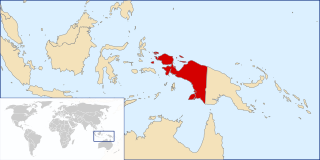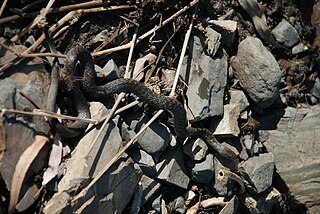
Papua New Guinea, officially the Independent State of Papua New Guinea, is a country in Oceania that comprises the eastern half of the island of New Guinea and its offshore islands in Melanesia. It shares its only land border with Indonesia to the west and it is directly adjacent to Australia to the south and the Solomon Islands to the east. Its capital, located along its southeastern coast, is Port Moresby. The country is the world's third largest island country, with an area of 462,840 km2 (178,700 sq mi).

Melanesia is a subregion of Oceania in the southwestern Pacific Ocean. It extends from New Guinea in the west to the Fiji Islands in the east, and includes the Arafura Sea.

The Territory of Papua comprised the southeastern quarter of the island of New Guinea from 1883 to 1975. In 1883, the Government of Queensland annexed this territory for the British Empire. The United Kingdom Government refused to ratify the annexation but in 1884 a protectorate was proclaimed over the territory, then called "British New Guinea". There is a certain ambiguity about the exact date on which the entire territory was annexed by the British. The Papua Act 1905 recites that this happened "on or about" 4 September 1888. On 18 March 1902, the Territory was placed under the authority of the Commonwealth of Australia. Resolutions of acceptance were passed by the Commonwealth Parliament, which accepted the territory under the name of Papua.

The indigenous peoples of Western New Guinea in Indonesia and Papua New Guinea, commonly called Papuans, are Melanesians. There is genetic evidence for two major historical lineages in New Guinea and neighboring islands: a first wave from the Malay Archipelago perhaps 50,000 years ago when New Guinea and Australia were a single landmass called Sahul and, much later, a wave of Austronesian people from the north who introduced Austronesian languages and pigs about 3,500 years ago. They also left a small but significant genetic trace in many coastal Papuan peoples.

Western New Guinea, also known as Papua, Indonesian New Guinea, Indonesian Papua, is the western, Indonesian half of the island of New Guinea. Since the island is alternatively named as Papua, the region is also called West Papua.

The common keelback, also known as Mair's keelback, is a species of nonvenomous snake in the family Colubridae. The species is endemic to Australasia.

Papua New Guinea has 326 local-level governments (LLGs) comprising 6,112 wards as of 2018.

Papua New Guinea, a sovereign state in Oceania, is the most linguistically diverse country in the world. According to Ethnologue, there are 840 living languages spoken in the country. In 2006, Papua New Guinea Prime Minister Sir Michael Somare stated that "Papua New Guinea has 832 living languages ."

New Guinea is the world's second-largest island, with an area of 785,753 km2 (303,381 sq mi). Located in Melanesia in the southwestern Pacific Ocean, the island is separated from Australia by the 150-kilometre wide Torres Strait, though both landmasses lie on the same continental shelf. Numerous smaller islands are located to the west and east. The name "New Guinea" was given by Spanish explorer Yñigo Ortiz de Retez during his maritime expedition of 1545 due to the resemblance of the indigenous peoples of the island to those in the African region of Guinea.
Tropidonophis doriae, commonly known as the barred keelback, is a species of snake belonging to the family Colubridae. The species is native to New Guinea and some nearby islands.

Tropidonophis is a genus of snakes in the subfamily Natricinae of the family Colubridae.
Tropidonophis montanus, the North Irian montane keelback, is a species of colubrid snake. It is found in New Guinea.
Tropidonophis aenigmaticus, the East Papuan keelback, is a species of colubrid snake. It is found on Fergusson Island in Papua New Guinea.
Tropidonophis dahlii, also known commonly as the New Britain keelback, is a species of snake in the family Colubridae. The species is native to Indonesia and Papua New Guinea.
Tropidonophis dolasii is a species of snake in the family Colubridae. The species is endemic to Papua New Guinea.
Tropidonophis hypomelas, the Bismarck keelback, is a species of colubrid snake. It is found in Papua New Guinea.
Tropidonophis mcdowelli, the Northern New Guinea keelback, is a species of colubrid snake. It is found in Indonesia and Papua New Guinea.
Tropidonophis multiscutellatus, the many-scaled keelback, is a species of colubrid snake. It is found in Papua New Guinea and Indonesia.
Tropidonophis novaeguineae, the New Guinea keelback, is a species of colubrid snake. It is found in New Guinea.
Tropidonophis parkeri, Parker's keelback or highland keelback, is a species of colubrid snake. It is found in Papua New Guinea.








